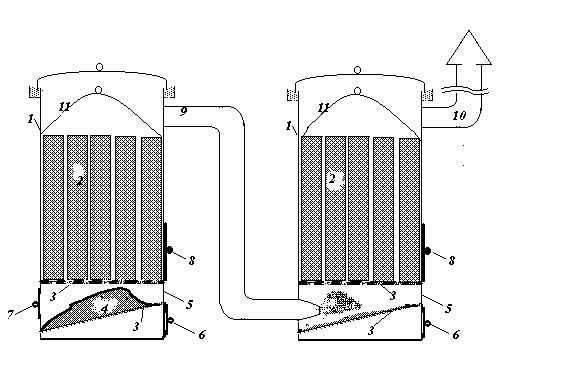The members of this mailing list actively discuss the production of charcoal from large pieces of wood. This problem is important for those countries of Asia and Africa, where there is a lot of
wood, a lot of working hands and few environment regulations. I think, it is better to offer a solution now than to wait for an ideal solution some time in the future.
I offer a variant of such a furnace.
This design is not protected by the patent so anybody can use it, where regulations permit.
In this figure the two cylinders are connected with each other. It is possible
to use only one device. Then pipe (9) is replaced with pipe (10) resulting in lower
efficiencies and higher emissions.
Each device is a metal cylinder. The top cover seals in a sand filled trough and
should have the handle for removal. A basket (11) of some smaller
diameter than the cylinder, is made of metal strips. The fire wood is stacked
in a basket vertically. A simple lift lifts the basket filled with fire wood (2) and
puts it in the cylinder (1). The cover is closed. If only one apparatus is used,
a small wood (4) fire is lit through hatch (7).
The hatch (7) is closed, and air supply from natural draft is controlled with
valves in the hatch (6). Air there passes through a grid-iron (lattice)
(3 - bottom), and hot gases act in the device through a grid-iron
(3 - top). It
is possible to judge the condition of the process by the form of smoke from the
chimney. During the drying stage the smoke is white, during pyrolysis it is yellow,
when it is finished it is transparent. The air valves on the
hatch (6) should be open only during the drying stage. The following stages continue
with the hatches closed. During the final stage the pipes are removed, the holes are sealed
and the coal cools down. When it has cooled down (from 12 hours about 2 days, depending on the sizes of the cylinder and fire wood) the lid is removed and the basket, now full of charcoal, is
removed. Fallen pieces of charcoal can be removed through hatch (8) and ashes through hatch (6). If the two units are connected as shown the gasses from the first cylinder can
be burned below the second. With a little care in construction the system can be made to switch easily back and forth. When the first one is finished it can be reloaded as the third batch, and so on.
For more information contact Dr Yury Yudkevitch via email at
woodcoal@mailbox.alkor.ru
Charcoal Plant
The factory will be rectangular in the plan. The walls can be made of temperature- proof concrete. The cassetes for row materials (cylinder) should be made of steel by thickness 10... 12 mm, are possible from pipes. It is necessary to have the lift, for cassetes. The time of cassete stay in each zone will be 8 hours. Once for 8 hours the cassete from charcoaler section takes out and put in a support for cooling. The cassete from dryer section puts in charcoaler section. A new cassete with fire wood puts in dryer section. A heat transport through a wall in charcoaler section and passage with a smoke through fire wood in dryer section. The top cover of the cassete is closed in charcoaler section and pyrolieses gases leave down stears, the top cover of cassete is open in dryer section and gases pass through row materials.

Pyrolieses gases burn in furnace completely and in air leaves water pairs and CO2. Furnace requires additional fire wood if temperature of air below 5 degrees C and if fire wood have a lot of moisture.

3

